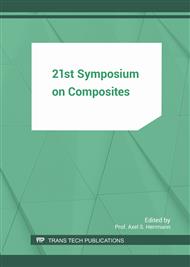p.652
p.660
p.666
p.673
p.681
p.689
p.697
p.705
p.714
Simulation of the Influence of Embedded Inserts on the RTM Filling Behavior Considering Local Fiber Structure
Abstract:
Resin Transfer Molding (RTM) enables an intrinsic manufacturing of fiber reinforced composite parts containing integrated metallic inserts. The inserts are embedded into the fiber layers in the preforming stage of the process and therefore influence the following mold filling. The fiber structure around the embedded insert is strongly influenced by the insert resulting in high local variations of fiber volume fraction which changes the local permeability. This leads to an inhomogenic flow front and can even result in dry spots of the cured part. To predict the formation of air bubbles, a two-phase mold filling simulation is used under consideration of local fiber volume fraction. Local fiber structure is determined using CT-scans of manufactured parts with different orientations of the insert in relation to the preform and to the filling direction. The mold filling simulations allow the evaluation of different filling strategies and show a strong influence of the insert on the local flow front propagation.
Info:
Periodical:
Pages:
681-688
Citation:
Online since:
July 2017
Authors:
Keywords:
Price:
Сopyright:
© 2017 Trans Tech Publications Ltd. All Rights Reserved
Share:
Citation:


